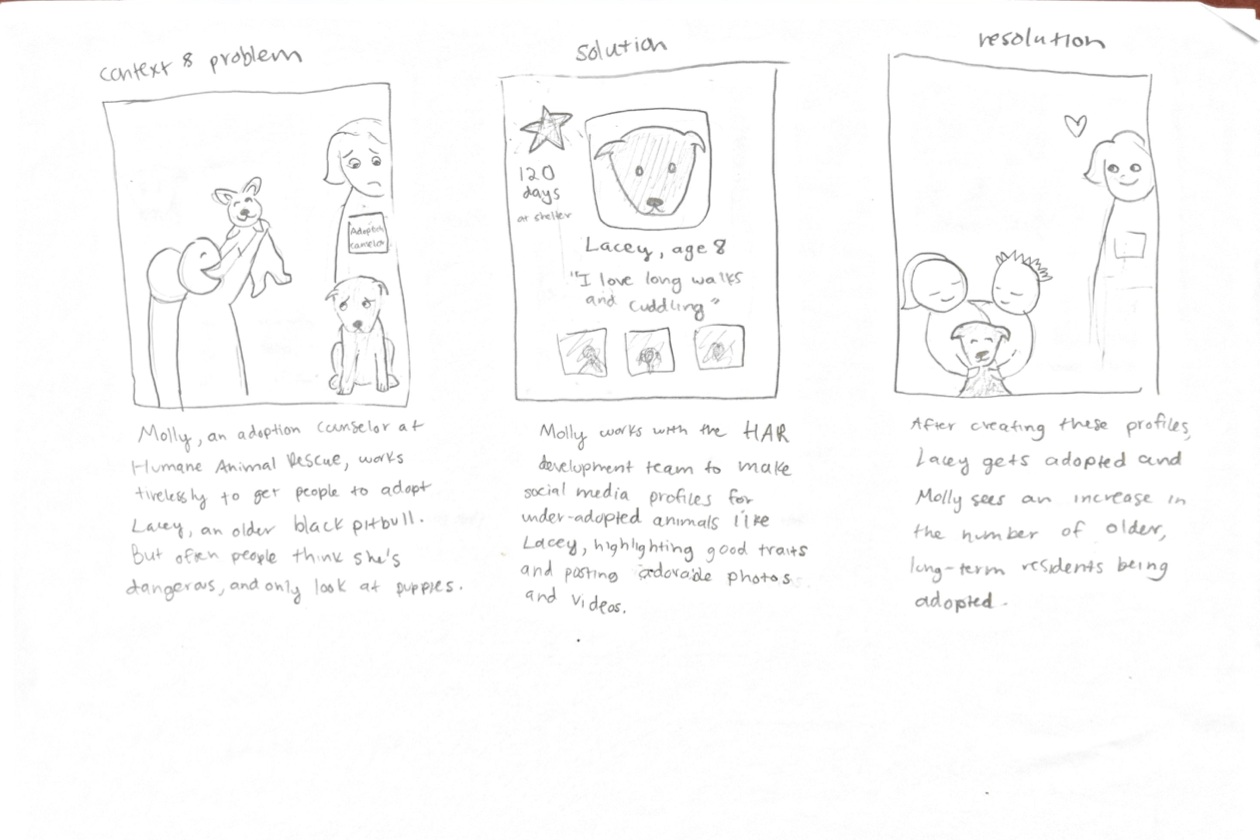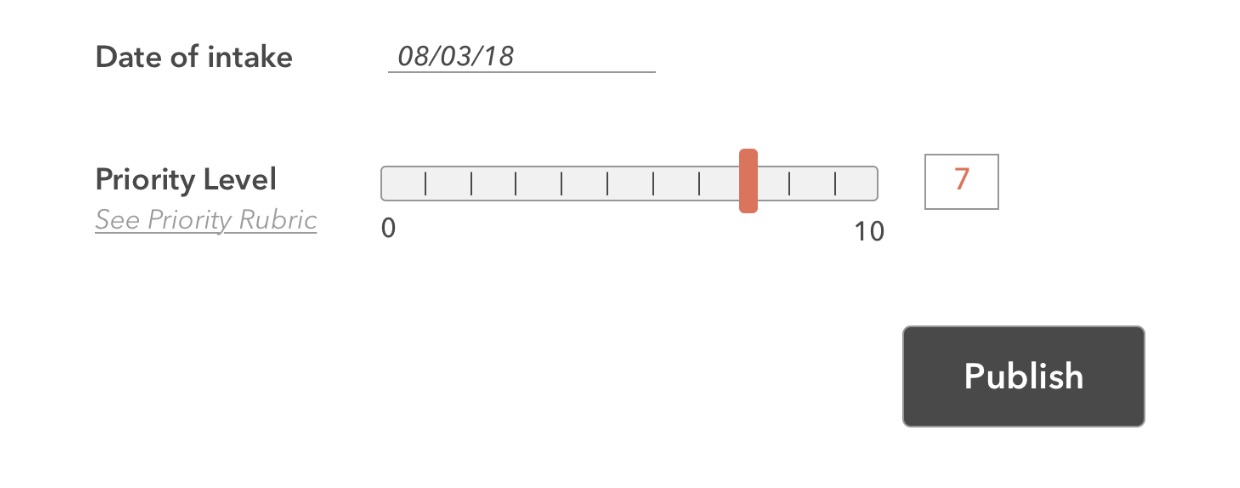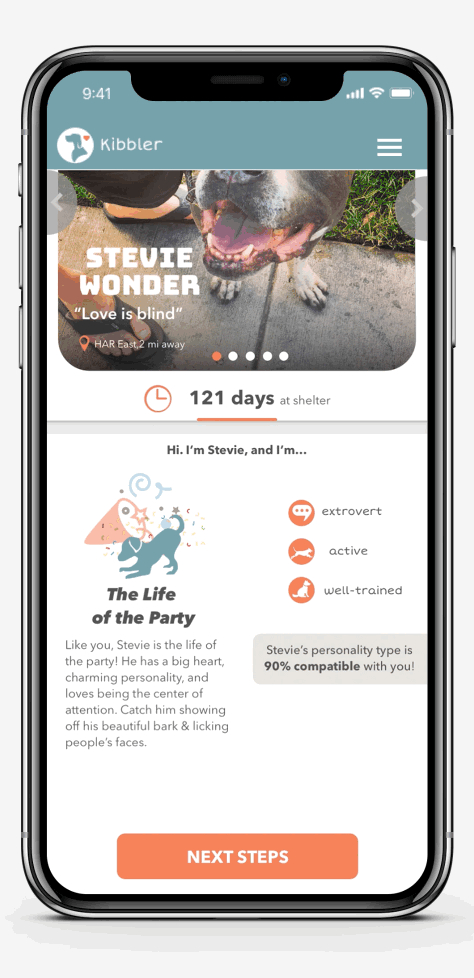Overview
Kibbler
Helping under-adopted animals find homes
Fall 2018 // 4 weeks
Carnegie Mellon University
Team Project // 3 people
Problem
Animal shelters want all their residents to find a forever home. However, certain dogs—black animals, animals with health issues, and bully breeds like pittbulls— often stay in the shelter for extended periods of time. This is both emotionally taxing and financially burdensome for shelters to deal with.
Solution
Kibbler is a web app that uses a matchmaking quiz to pair potential adopters with dogs that fit their personality and lifestyle. By bumping under-adopted animals to the top of the matchmaking pool and focusing on dog personality rather than elements like breed and age, we reduce chances of discrimination and give under-adopted dogs a better chance at finding a forever home. The usefulness of this solution was validated by shelter employees.
Methods
Guerrilla Research, Journey Mapping, Speed-Dating, Paper Prototyping, Think Alouds
Tools
Sketch, Figma
Role
I contributed mainly to visual design and concept definition. The concept video was created individually by me.
CONCEPT VIDEO
Background
DESIGN ROADMAP
“It’s hard for us to see someone not think this amazing animal is as wonderful as he is. Another tough part is seeing them get looked over day after day. Some customers can be very difficult. They want what they want and how they want it and won’t listen to a word we say. ”
PROJECT CONTEXT
How might we increase adoption of traditionally under-adopted shelter animals, providing value to pet adopters and animal shelters?
This project was created for a class called Interaction Design Studio at Carnegie Mellon University. My team was tasked with designing a web app that meets the needs of multiple pet adoption stakeholders.
Pet adoption is defined as the act of providing a home to an animal in need, whether stray, abandoned, or surrendered to a shelter. It is not purchasing a pet from a breeder or pet shop.
We designed the Kibbler in only 4 weeks, rapidly conducting “guerrilla” user research, developing design ideas, and testing them with users. The final prototype is a concept for a web application benefits multiple stakeholders. It helps animal shelter employees/business owners by increasing adoption rates of long term shelter residents, which mitigates both emotional and financial strain. At the same time, it helps customers by narrowing down the overwhelming number of animals to choose from and matching them to a companion that best suits their personality and lifestyle.
Process
1. Research
In the early phases of this project, we engaged in multiple methodologies to better understand the state of pet adoption. This included secondary research, guerrilla research (contextual interviews), and journey mapping.
SECONDARY RESEARCH
We began by conducting secondary research, browsing adoption sites and informational pages about pet adoption. Through our secondary research, we found that there are many ways in which people can adopt animals. However, we chose to focus on shelter options in Pittsburgh. We defined our stakeholders as follows:
Customer: Individual pet adopters
Service Providers: Pet adoption counselors
Owners: Shelter leadership
GUERRILLA RESEARCH
Next, we got our hands dirty with fast-paced and informal guerrilla research. We traveled to 3 different adoption centers, chatting with business managers, adoption counselors, and pet adopters to identify needs and breakdowns concerning our three stakeholders.
A dog at ASAP Rescue, one of the shelter options in Pittsburgh.
Employees at Humane Animal Rescue, another adoption center.
ANALYZING THE DATA
Using the data gathered from guerrilla research, we constructed customer journey maps and personas in order to better empathize with our stakeholders and identify potential solutions that could address shared pain points.
We decided to focus on dogs in order to narrow the problem scope and design a more effective, specific solution that did one thing really well.
Journey Maps

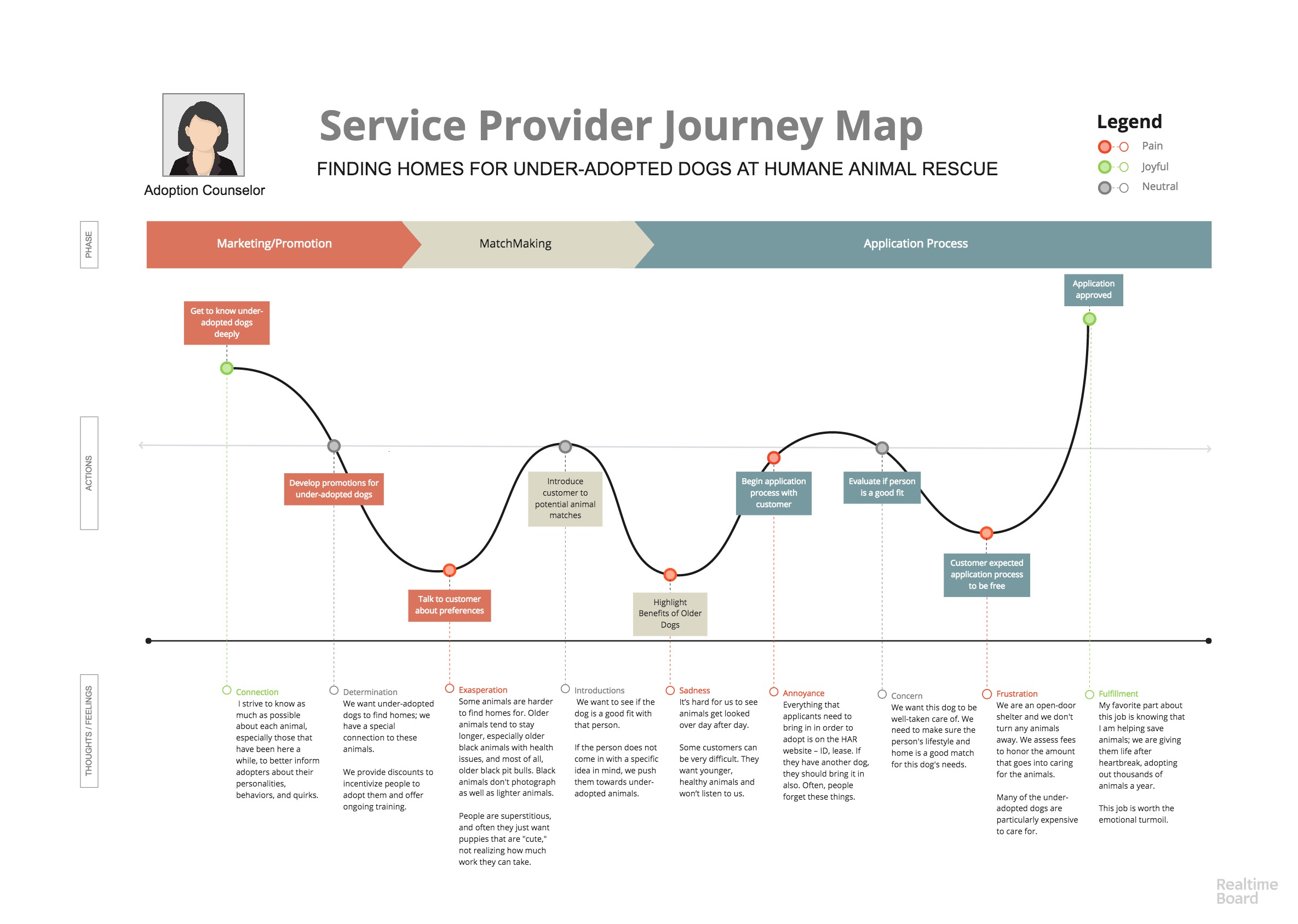
Personas
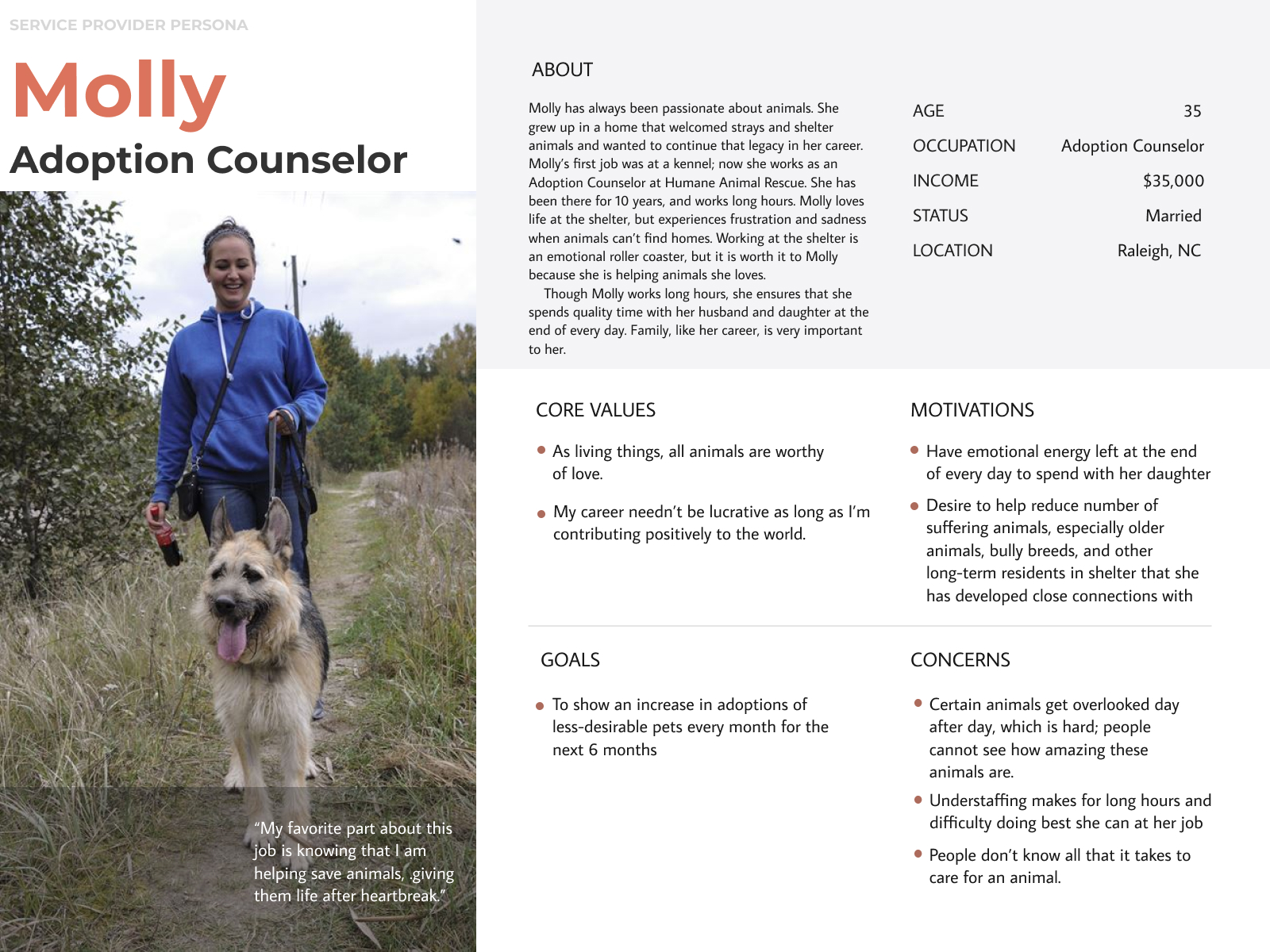
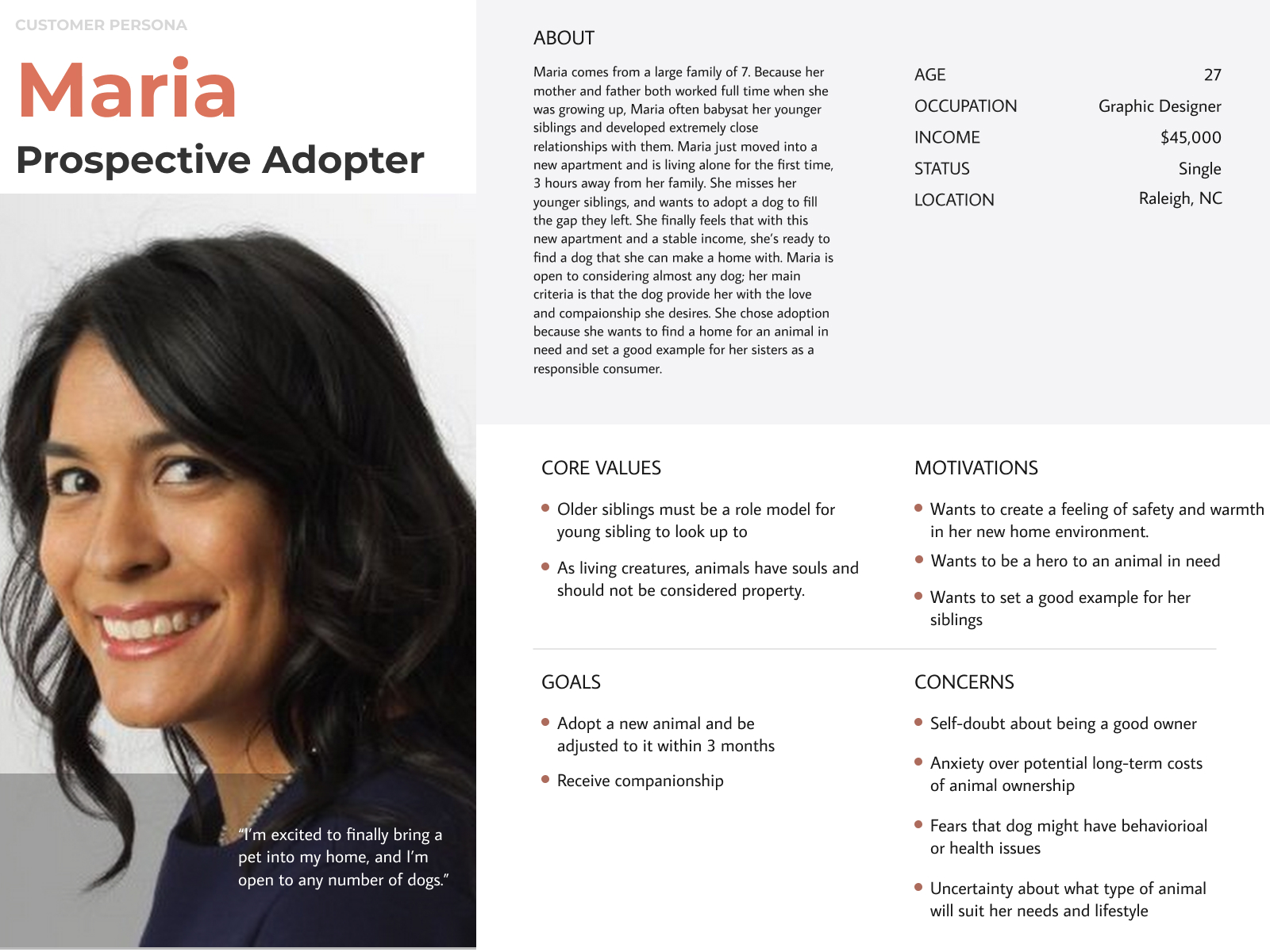
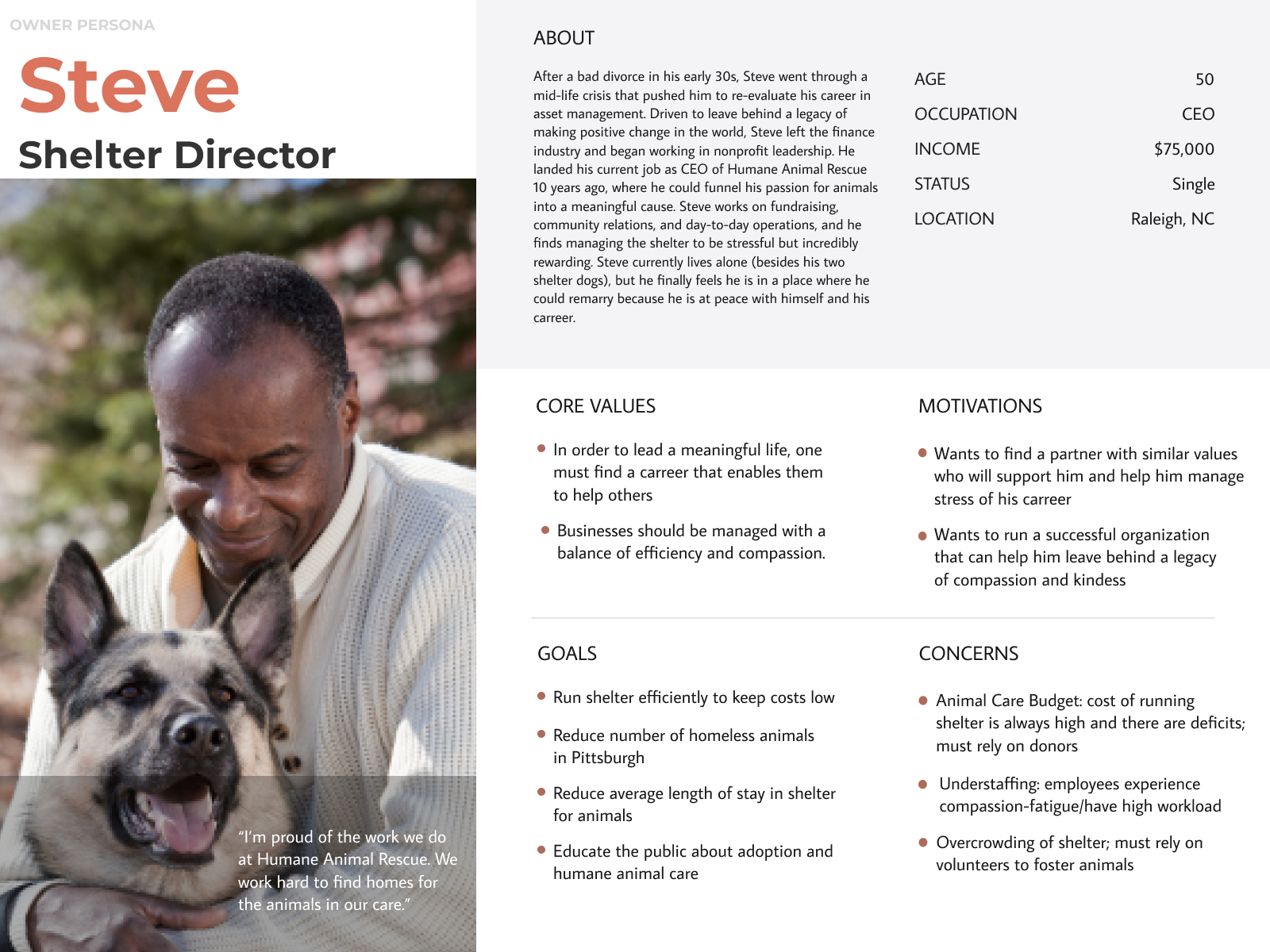
INSIGHTS
Adoption Counselors/Shelter Directors
Interviewing both adoption counselors (service provider) and shelter management (business owners) revealed to us that their needs and values were well aligned. Our interviews helped us arrive at the following insights:
Animal wellbeing is the #1 priority for shelters
“We have a very close connection with our animals. I personally thrive to know as much as possible about each one to better inform potential adopters with their personalities/behaviors/quirks. Our priority is finding them their forever home.”
———
Most everyone who works at the animal shelter is passionate about animals. They have deep emotional bonds with these animals, and put animal wellbeing first. If the animals are happy, they are happy.
Keeping animals in the shelter for long periods of time is both emotionally and financially taxing for shelters
“Most people want a puppy or a kitten because they’re cute and they can’t see anything beyond that. It’s really hard for us to see great animals get overlooked.”
———
Certain animals, particularly black animals, older animals, bully breed like pitbulls, and animals with health issues have trouble finding homes. People come in with preconceived notions of those animals, and overlook them. This places a financial burden on shelters, which tend to be underfunded and overcrowded. It is also extremely emotionally draining for adoption counselors to see their beloved animals get passed over every day.
Dog Adopters
In our research, we found that there were two types of dog adopters: ones that know exactly what kind of dog they want (puppy, hypoallergenic, etc.) and those that go into the adoption process with an open mind. We decided to target the latter because we saw more flexibility in design opportunities with this population.
Compatibility with animal is #1 priority for adopters
“What’s most important is making sure the dog is compatible with me. Personality is key.”
———
Customers always visit shelters before to test for compatibility. Most said this was the most important factor in choosing an animal.
Choosing an animal at the adoption center can be an overwhelming & anxiety-provoking experience
“I’m afraid I’ll fall in love with every animal I see!”
———
Potential adopters are bombarded by new people, strangle smells, and an overwhelming amount of choices. People often fall in love with multiple animals and have difficulty picking one to take home. They often also have anxiety about shelter animals having health problems and behavioral issues.
2. Define & Ideate
PROBLEM STATEMENT
Taking insights gathered from generative research, we defined our problem as follows:
Certain types of shelter dogs — bully breeds, older dogs, dogs with health issues, black dogs — get passed over for adoption.
The next stage was to begin ideating, designing a solution that solved this problem for the animal shelter stakeholders while also providing value to the dog adopters.
IDEATION
We brainstormed potential solutions to our problem statement, creating storyboards for our favorite ideas. Click into each photo to see a larger image.
Sample Storyboards
Dog-match lifestyle quiz
“Mythbusters” website to dispel dog stereotypes
Social media platform for dogs
“Postmates for dogs”: a dog delivery service
SPEED DATING
We went through two rounds of “speed dating” with the storyboards we created, asking both dog adopters and adoption counselors what they thought of each in order to validate (or invalidate) identified needs and initial design ideas. We then iterated our storyboards based on user feedback and re-tested them. This helped us get quick and useful data about design ideas without having to build anything!
The results easily showed that our idea for a dog matchmaking service held the most promise, so we moved forward with it.
This idea met the needs of all stakeholders found during guerrilla research; it served shelter workers by reducing the burden of under-adopted animal and helping customers see the beauty in all animals, and benefitted customers by narrowing down choices, ensuring compatibility, and preventing anxiety that comes from uncertainty during the animal adoption process.
3. Prototype and Evaluate
COMPETITIVE ANALYSIS
Before we began prototyping, we conducted a competitive analysis of pet-finding tools to determine how we could differentiate ourselves and provide new value to users. We found that popular tools, like petfinder, primarily sort dogs by demographic characteristics like breed, age, and size. Personality and compatibility are often not considered. We conjectured that this may lead to lots of wonderful dogs with great personalities being overlooked due to their age or breed.
BUILD
Initial Wireframe
Next, we built out a flow for our web app, emphasizing that there would be two portals: once for the service provider, and one for the potential adopter.
Low Fidelity Mockups
After drawing out the wireframe, we began prototyping low-fidelity screen mockups in Figma. There are two sets of screens: one set for the service provider to upload/manage dog profiles, and one set for the customer to interact with those profiles. We tested them with several users and received feedback about flow, functionality, and content.
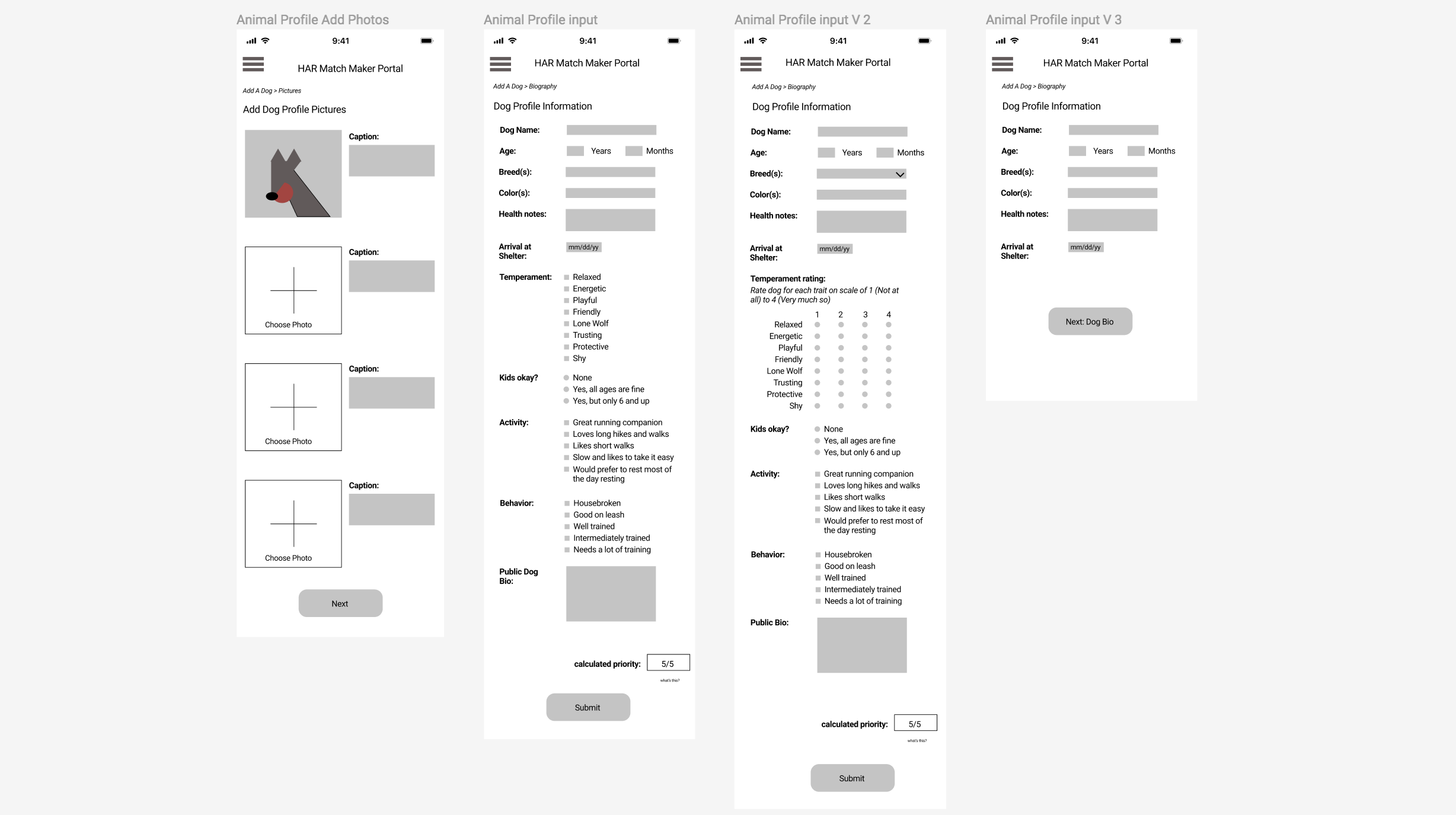

TAKEAWAYS
Make it playful & personality-focused
We found that our intent to highlight dog personality wasn’t coming through—we needed to remove information about age, breed, and price from the platform, focusing solely on the personality traits of the dogs. We also needed to use more playful language and graphics to build ethos—our screens felt dry and analytical to potential adopters.
Reduce burden on adoption counselors
On the side of the service provider, we needed to simplify the process of creating dog profiles for them—adoption counselors are extremely busy and overworked, and so cannot spend a lot of time filling out the profile.
Final Design
4. Refined Prototype
KIBBLER: FINDING HOMES FOR LONG-TERM SHELTER RESIDENTS
Kibbler is a web application that helps under-adopted dogs find forever homes. It does this by matching potential adopters to dogs that are compatible with their lifestyle and personality, removing demographic information to avoid discrimination based on characteristics like age and breed. Instead, the app highlights dog personality so users can find the animal that’s truly right for them, serving as a catalyst for the adoption process. The platform uses a ranking system to bump under-adopted animals to the top of the matching pool for better visibility.
Kibbler addresses both unmet customer need for a dog adoption search tool that leverages customer personality to make matches (reducing paradox of choice), and the problem of under-adoption faced by animal shelter stakeholders.
Adoption Counselor:
MINIMAL EFFORT, MAXIMAL REWARD
Easy Profile Upload
In order to make Kibbler an implementable digital solution to our client’s problem, uploading dog profiles would have to add very little work to the shelter employees’ day-to-day responsibilities.
To address this constraint, we designed the input screen to complement current dog intake. After the staff member adds a dog profile to the system, are re-directed to Kibbler, where can link the dog by ID number to autofill information like date of intake, name, and priority number (explained on right). Additionally, adoption counselors would be able to quickly generate a biography for a new dog by selecting one of six personality types and ticking a series of checkboxes.
Priority to Under-Adopted Animals
A priority level is auto-calculated based on demographic information input at intake (age, breed, etc.) using a priority rubric to bump under-adopted animals to the top of the matching pool—for example, since Pitbulls are less likely to be adopted, they will be given higher priority. This increases visibility of under-adopted dogs, addressing the shelter need to increase the low adoption rate of under-adopted animals.
However, it is important to note that customers will still only be matched with under-adopted animals if their personalities are compatible.
Dog Adopter:
THE PERFECT MATCH
Personality Quiz
We built out a series of fun questions to elicit key information about potential adopters’ personalities and lifestyles that would help identify the personality of dog that would be the best fit for any given individual. For example, if a person states that they spend most of the weekend sitting on the couch, they will have a higher chance of being matched with a low energy, calm dog.
The quiz is entertaining and reveals potentially unknown information about the self—much like the oft-used Buzzfeed personality quizzes. This incentivizes customers to take it.
Compatible Dogs
Based on the answers given in the personality quiz, the user is matched with three dogs that fit their lifestyle and personality. We chose three because it was a number that made the users feel like they had freedom of choice but did not overwhelm them with options, an issue they often encountered at the shelter.
Action Items to Encourage Adoption
After receiving their matches, users are given actionable steps to take in order to encourage them to adopt, catalyzing the process. Location was listed first so users could quickly discover where to find their animal and easily get directions to visit them. Moreover, our research showed that people often forget to bring their lease and license, so including this information is key to enabling successful adoptions.
Looking Beyond Appearance
By including a personality “tagline”, fun graphics, and playful language, we hope customers feel emotional connection and hopefulness when they get their matches. We also made efforts to de-emphasize dog demographic information and to play up personality. This helps under-adopted dogs, who would otherwise be discriminated against for age or breed, be seen a new, positive light.
This app is meant to be a starting point in the adoption process, increasing visibility of dogs who would otherwise go unnoticed. Because this app is just the catalyst for adoption, we felt removing demographic information like age and breed was not detrimental. Users can get more information about dog demographics when they visit the shelter.
BRANDING DECISIONS
From the first to second hi-fi iteration, we changed the color palette from brighter, saturated colors to a more neutral scheme. This was done to keep the feel upbeat and hopeful while still conveying credibility. The earlier hi-fi mockups were a little too playful in color choice, creating a somewhat childish, unprofessional feel.
Another change between iterations was consolidating information into 1 tab for a more streamlined user experience.
REFLECTION
If I had more time, I would…
Conduct experiments to determine if the proposed solution would actually increase the adoption rate of hard-to-place animals. Though my team conducted user-testing that provided feedback on app usability and enjoyment, we didn’t have time to design a study to determine if the app was in fact successful in its goal of finding homes for under-adopted animals.
Flesh out algorithm for animal-matching. If the project was longer, I would spend more time considering the details of how the app would pair humans to dogs based on personality quiz questions.













